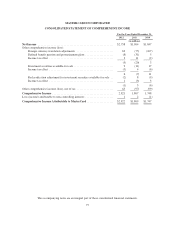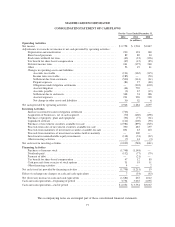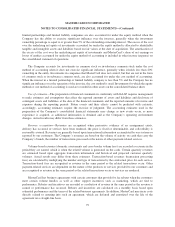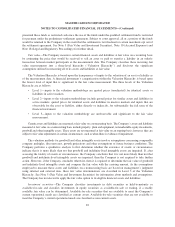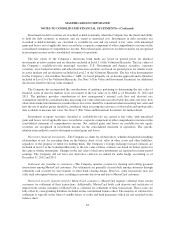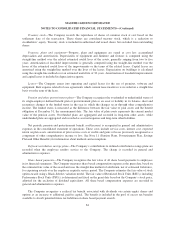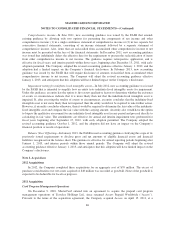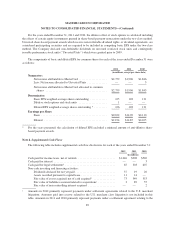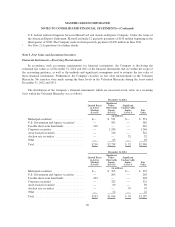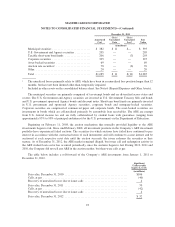MasterCard 2012 Annual Report Download - page 89
Download and view the complete annual report
Please find page 89 of the 2012 MasterCard annual report below. You can navigate through the pages in the report by either clicking on the pages listed below, or by using the keyword search tool below to find specific information within the annual report.MASTERCARD INCORPORATED
NOTES TO CONSOLIDATED FINANCIAL STATEMENTS—(Continued)
Advertising expense—The cost of media advertising is expensed when the advertising takes place.
Advertising production costs are expensed as incurred. Promotional items are expensed at the time the
promotional event occurs. Sponsorship costs are recognized over the period of benefit based on the estimated
value of certain events.
Foreign currency remeasurement and translation—For foreign currency remeasurement from each local
currency into the appropriate functional currency, monetary assets and liabilities are remeasured to functional
currencies using current exchange rates in effect at the balance sheet date. Non-monetary assets and liabilities are
recorded at historical exchange rates, and revenue and expense accounts are remeasured at a weighted-average
exchange rate for the period. Resulting exchange gains and losses related to remeasurement are included in
general and administrative expenses on the consolidated statement of operations.
Where a non-U.S. currency is the functional currency, translation from that functional currency to
U.S. dollars is performed for balance sheet accounts using current exchange rates in effect at the balance sheet
date and for revenue and expense accounts using a weighted-average exchange rate for the period. Resulting
translation adjustments are reported as a component of other comprehensive income (loss).
Earnings per share—The Company calculates earnings per share (EPS) by dividing net income attributable
to MasterCard by the weighted-average number of common shares outstanding during the year. Diluted EPS is
calculated by dividing net income attributable to MasterCard by the weighted-average number of common shares
outstanding during the year, adjusted for the potentially dilutive effect of stock options and unvested stock units
using the treasury stock method. For the years ended December 31, 2011 and 2010, EPS was calculated using the
two-class method. The two-class method clarifies that unvested share based payment awards that contain
nonforfeitable rights to dividends or dividend equivalents are considered participating securities and should be
included in the calculation of EPS. See Note 3 (Earnings Per Share) for further detail.
Recent accounting pronouncements
Fair value measurement and disclosure—In May 2011, the fair value accounting guidance was amended by
the FASB to change fair value measurement principles and disclosure requirements. The key changes in
measurement principles include limiting the concepts of highest and best use and valuation premise to
nonfinancial assets, providing a framework for considering whether a premium or discount can be applied in a
fair value measurement, and aligning the fair value measurement of instruments classified within an entity’s
shareholders’ equity with the guidance for liabilities. Disclosures are required for all transfers between Levels 1
and 2 within the Valuation Hierarchy, the use of a nonfinancial asset measured at fair value if its use differs from
its highest and best use, the level in the Valuation Hierarchy of assets and liabilities not recorded at fair value but
for which fair value is required to be disclosed, and for Level 3 measurements, quantitative information about
unobservable inputs used, a description of the valuation processes used, and qualitative discussion about the
sensitivity of the measurements. The Company adopted the revised accounting guidance effective January 1,
2012 via prospective adoption, as required, and the adoption did not have an impact on the Company’s financial
position or results of operations.
Impairment testing for goodwill—In September 2011, a new accounting guidance was issued that is
intended to simplify how an entity tests goodwill for impairment. Entities are permitted to perform a qualitative
assessment of goodwill impairment to determine whether it is necessary to perform the two-step quantitative
goodwill impairment test. This guidance is effective for goodwill impairment tests performed in interim and
annual periods for fiscal years beginning after December 15, 2011, with early adoption permitted. The Company
adopted the revised accounting guidance October 1, 2011. The adoption did not have an impact on the
Company’s financial position or results of operations.
85


